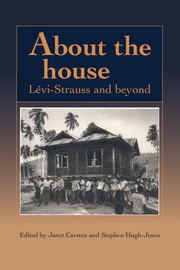Book contents
- Frontmatter
- Contents
- List of illustrations
- List of contributors
- 1 Introduction
- 2 Houses and hierarchies in island Southeast Asia
- 3 The resurrection of the house amongst the Zafimaniry of Madagascar
- 4 The hearth-group, the conjugal couple and the symbolism of the rice meal among the Kelabit of Sarawak
- 5 Houses in Langkawi: stable structures or mobile homes?
- 6 Having your house and eating it: houses and siblings in Ara, South Sulawesi
- 7 The Lio House: building, category, idea, value
- 8 Houses and hierarchy: the view from a South Moluccan society
- 9 Houses, places and people: community and continuity in Guiana
- 10 The houses of the Mẽbengokre (Kayapó) of Central Brazil – a new door to their social organization
- 11 Inside-out and back-to-front: the androgynous house in Northwest Amazonia
- Notes
- Bibliography
- Index
11 - Inside-out and back-to-front: the androgynous house in Northwest Amazonia
Published online by Cambridge University Press: 05 June 2012
- Frontmatter
- Contents
- List of illustrations
- List of contributors
- 1 Introduction
- 2 Houses and hierarchies in island Southeast Asia
- 3 The resurrection of the house amongst the Zafimaniry of Madagascar
- 4 The hearth-group, the conjugal couple and the symbolism of the rice meal among the Kelabit of Sarawak
- 5 Houses in Langkawi: stable structures or mobile homes?
- 6 Having your house and eating it: houses and siblings in Ara, South Sulawesi
- 7 The Lio House: building, category, idea, value
- 8 Houses and hierarchy: the view from a South Moluccan society
- 9 Houses, places and people: community and continuity in Guiana
- 10 The houses of the Mẽbengokre (Kayapó) of Central Brazil – a new door to their social organization
- 11 Inside-out and back-to-front: the androgynous house in Northwest Amazonia
- Notes
- Bibliography
- Index
Summary
In recent years it has become increasingly evident that the small, fragmented tribes of Amazonian ethnography, twin products of colonial genocide and academic classificatory ethnogenesis, are poor guides for understanding an area once integrated by complex regional systems. If anthropologists have long recognized a fundamental unity beneath the manifest linguistic and cultural diversity of Amazonia, progress towards synthesis has been relatively slow. In studies of kinship, progress has often been hampered by the use of outmoded and alien theoretical models which delimit an artificially narrow field of study and square uneasily with local idioms.
Although there are a number of publications on architectural and spatial symbolism in different parts of lowland South America, many treat architecture as a sphere of analysis relatively independent from kinship and social structure. In this chapter I want to extend previous explorations of the significance of Northwest Amazonian architecture in a new direction by suggesting that their communal longhouses provide the eastern Tukanoan-speaking peoples with a way of conceptualizing their own social structure, one which is misrepresented and distorted when translated as unilineal descent. At the same time, I shall examine whether such native idioms are usefully included under Lévi-Strauss's (1983a, 1987) general rubric of ‘house societies’.
My argument can be summarized as follows. Tukanoan social structure has typically been characterized in terms of patrilineal descent, virilocal residence, symmetric alliance, and a Dravidian relationship terminology, and described as an open-ended social system made up of a number of intermarrying exogamous language groups each internally divided into sets of ranked clans.
- Type
- Chapter
- Information
- About the HouseLévi-Strauss and Beyond, pp. 226 - 252Publisher: Cambridge University PressPrint publication year: 1995
- 30
- Cited by



